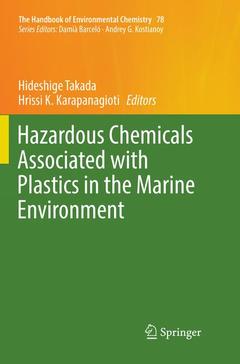Description
Hazardous Chemicals Associated with Plastics in the Marine Environment, 1st ed. 2019
The Handbook of Environmental Chemistry Series, Vol. 78
Coordinators: Takada Hideshige, Karapanagioti Hrissi K.
Language: English
Subjects for Hazardous Chemicals Associated with Plastics in the...:
Publication date: 12-2018
Support: Print on demand
Publication date: 10-2018
Support: Print on demand
Description
/li>Contents
/li>Comment
/li>
Additives and Chemicals in Plastics.- Food Containers and Packaging Materials as Possible Source of Hazardous Chemicals to Food.- Release of additives and monomers from plastic wastes.- Degradation of various plastics in the environment.- Occurrence of Marine Litter in the Marine Environment: A World Panorama of Floating and Seafloor Plastics.- Sources, Distribution, and Fate of Microscopic Plastics in Marine Environments.- Nature of Plastic Marine Pollution in the Subtropical Gyres.- Hazardous chemicals in plastics in marine environments: International Pellet Watch.- Sorption of hydrophobic organic compounds to plastics in marine environments: equilibrium.- Sorption of Hydrophobic Organic Compounds to Plastics in the Marine Environment: Sorption and Desorption Kinetics.- Biofilms on Plastic Debris and Their Influence on Marine Nutrient Cycling, Productivity, and Hazardous Chemical Mobility.- Ingestion of plastics by marine organisms.- Transfer of hazardous chemicals from ingested plastics to higher-trophic level organisms.- The Role of Plastic Debris as Another Source of Hazardous Chemicals in Lower-Trophic Level Organisms.- Conclusions of “Hazardous Chemicals Associated with Plastics in Environment”.- Erratum to: Food Containers and Packaging Materials as Possible Source of Hazardous Chemicals to Food.
Provides new insights into the environmental impact of chemicals associated with plastics
Identifies research points that need to be addressed in the future
Will appeal to environmental managers, scientists and policymakers




